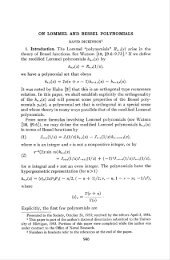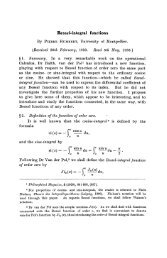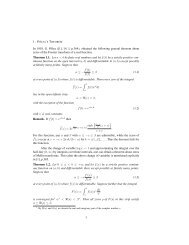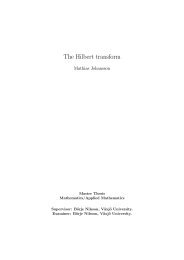C. Fox Solving integral equations by L and L(-1 ... - Fuchs-braun.com
C. Fox Solving integral equations by L and L(-1 ... - Fuchs-braun.com
C. Fox Solving integral equations by L and L(-1 ... - Fuchs-braun.com
Create successful ePaper yourself
Turn your PDF publications into a flip-book with our unique Google optimized e-Paper software.
304 CHARLES FOX [Julyapply the Parseval theorem (10) to the right-h<strong>and</strong> side of (24) <strong>and</strong>obtain(25) git) = — f 2«+-*r(|i)r(§i + *)F(1 - s)t-'ds,where Fis) is the Mellin transform of fix). If we may use (4) thenL^lgit112)} eliminates TQs) from (25) <strong>and</strong> then, after writingx = 1/i, L-ltr"-1 eliminates r(|s+v). The final result is(26) L-i[t—i{[L-i\gitV2)}Ullt\] = 2—f— f Fií - s)i2x^2)-^ds,¿in J c(27) = 2^Ix'-1'2/(2x1'2),where, in (26), 5 is replaced <strong>by</strong> 1—s <strong>and</strong> then (9) is used to obtain(27), as in going from (16) to (17). (27) is then our solution of (24).If. e.g., git) = 1 /(i2+a2) then, from [l, p. 229, (1)], we haveL-1{git1'2)}=expi-a2x) <strong>and</strong> from [l, p. 245, (40)],(28) L-^t-'-'e-'2"} = a-'xr'Vtfax1!*).From (27), for this choice of git), our solution of (24) is(29) fix) = a~'x1-'J,iax).This solution is easily checked from the K, tables [2, p. 137, (16)]with v= —p, noting that the tables have («i)I/2 in the integr<strong>and</strong> of(24) instead of (mí)' as we have.7. Some general remarks. Suppose that we have the <strong>integral</strong>equationoÄ(«x)/(x) dx,where g{u) <strong>and</strong> kiux) are given <strong>and</strong>/(x) is to be found. On applyingthe Parseval theorem for Mellin transforms (10) to the right-h<strong>and</strong>side of (30) we find that instead of having one Gamma function inthe numerator <strong>and</strong> one in the denominator, as in (12), we haven?=i r(a¿s-f-/3i) in the numerator <strong>and</strong> H x TiajS+ßs) in thedenominator. Then we can proceed as follows:(i) <strong>by</strong> means of an m succession of L operators we can eliminate allthe Gamma functions from the denominator, as in the eliminationfrom (12) to (13) <strong>and</strong>(ii) <strong>by</strong> means of an n succession of L~x operators we can eliminate allthe Gamma functions from the numerator, as in going from (25) to(26).












